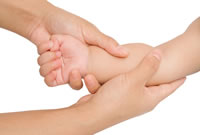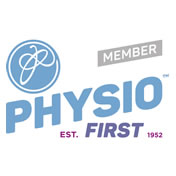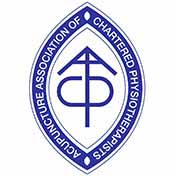Erb’s Palsy is an injury to the brachial plexus that is usually sustained during birth. As the brachial plexus is a large bundle of nerve fibres located between the neck and the shoulder, trauma to this area causes movement and sensory dysfunction within the upper limb of the injured side. During birth, if a large traction force is placed on the neck of the baby, or if the head and neck are significantly overstretched to one side, the brachial plexus can become be injured. Post-delivery, a baby who has suffered a trauma to their brachial plexus may present with muscle weakness and sensory changes to the affected upper limb. The severity and extent of this injury will vary depending upon the nature of the trauma. In general, the nerve pathways that are commonly affected are those originating from C5 and C6 (cervical) nerve roots, but on some occasions, nerve branches lower down the cervical spine may also be affected.
 Initially, any upper limb problems may be difficult to detect, other than an apparent reduction in general movement of the affected arm. As a child grows and develops, significant brachial plexus deficits may become more obvious as an individual struggles to use their arm for more advanced functional movements and upper limb activities. This may present as difficulty in lifting the affected arm away from the side of the body (abduction) causing the arm to loosely hang at the side of the body, rotated inwards from the shoulder. There may also be associated reduced sensation and absence of a biceps reflex on that side. Functionally this can profoundly affect a child who, because of their injury, struggles to raise their affected arm above their head, get dressed independently, or join in certain activities at school.
Initially, any upper limb problems may be difficult to detect, other than an apparent reduction in general movement of the affected arm. As a child grows and develops, significant brachial plexus deficits may become more obvious as an individual struggles to use their arm for more advanced functional movements and upper limb activities. This may present as difficulty in lifting the affected arm away from the side of the body (abduction) causing the arm to loosely hang at the side of the body, rotated inwards from the shoulder. There may also be associated reduced sensation and absence of a biceps reflex on that side. Functionally this can profoundly affect a child who, because of their injury, struggles to raise their affected arm above their head, get dressed independently, or join in certain activities at school.
In less severe cases, some babies recover from Erb’s Palsy spontaneously within their first few weeks post-delivery. In general, a good recovery tends to be observed in those whose upper cervical nerve branches have been injured. More severe brachial plexus traumas may take up to 2 years to recover, some never fully, presenting with persistent upper limb weakness of the affected arm and a visibly smaller muscle bulk of the whole arm. With this type of presentation, often both the upper and lower cervical nerves have been traumatised leading to what is termed ‘global brachial plexus palsy’.
Children who show slower recovery following and Erb’s Palsy within the first 3 months of birth are normally referred to a Consultant Neurosurgeon for assessment and possible further investigations. Physiotherapy is often required for those individuals who do not show signs of independent recovery. Physiotherapy management includes passive upper limb stretching and appropriate positioning in order to prevent the development of soft tissue and joint contractures. Massage, facilitation of normal movement patterns and functional strengthening programmes are also important components of physiotherapy rehabilitation. Post-operative physiotherapy following surgical intervention in the more severe cases of Erb’s Palsy, is crucial in order to maximise upper limb movement, prevent soft tissue contractures, and functionally rehabilitate a child fully.
It is important that a child’s family / carers are actively involved in the physiotherapy management and rehabilitation process from the outset. Physiotherapeutic handling and exercises can then be continued between physiotherapy appointments to ensure the optimal outcome of rehabilitation and any surgery undertaken, and the greatest functional potential for the child.
If you would like to know more about the physiotherapy involved in the rehabilitation of a child with Erb’s palsy, please get in touch. One of our Specialist Paediatric Physiotherapists will be happy to talk things through with you over the phone and we can arrange an appointment for an assessment of your child if necessary.





